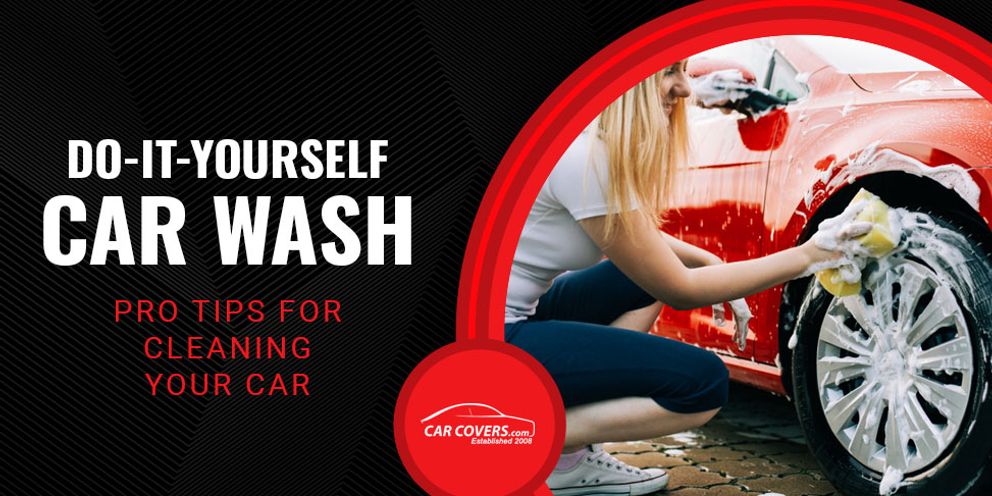
Do It Yourself Car Wash: Pro Tips for Cleaning Your Car
Many people take pride in the vehicle they drive. Having a clean and well-maintained car is gratifying and makes your driving experience more enjoyable. Dust, debris, and salt can accumulate on the vehicle’s exterior, contributing to damaged paintwork or rust. If left untreated, corrosion can ruin car engines, leading to costly repairs. Regularly cleaning your car, inside and out, can reduce the risk of damage and help maintain the value of your vehicle. Unfortunately, visiting the car wash every couple of weeks is expensive and time-consuming, and the drive-thru car wash brushes can scratch your paint job. A do-it-yourself car wash at home is a much more cost-effective approach. With the right equipment and some basic knowledge of how to wash a car, regular maintenance can become a labor of love. Here’s a look at some pro tips for cleaning your car.
Exterior Cleaning
Exterior cleaning is the best way to keep your car looking new and aesthetically pleasing. But besides the obvious reasons to clean your car’s exterior, regular washing is key to limiting unnecessary engine and chassis damage.
Planning and Preparation
Before beginning the cleaning process, take some time to research the best cleaning products for your vehicle and ensure you have everything you need easily accessible. You’ll also want to check the weather forecast on the day you plan to do the washing. It’s best to pick a day that’s not exceptionally hot or sunny because extreme heat can cause the shampoo to dry on your car before you have an opportunity to rinse it off. Assess the condition of your vehicle and determine what needs to be done. If you’ve spent a week by the coast, you may need a mixture of water and vinegar to remove any harmful salt or moisture build-up. However, if you’ve got some dirt buildup from driving on muddy country roads, car shampoo should provide a sufficient clean. Once you’ve determined the extent of the cleaning job, ensure you have the right supplies, which include the following tools and maintenance products:
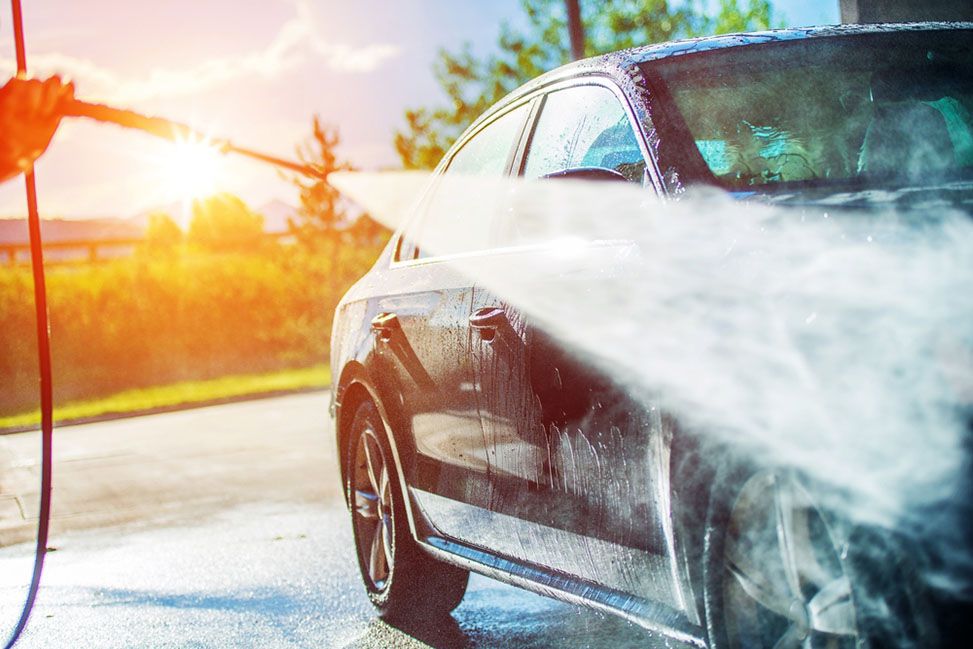
Tools
• Hose or power washer
• Sponge
• Wheel brush
• Soft-bristled toothbrush
• Three buckets
• Washing mitts
• Multiple microfiber towels
• Clay bar
• Screwdriver
• Cotton swabs
• Vacuum cleaner with narrow nozzle and brush attachments
• Buffing machine with polishing pads (optional)
• Leaf blower (optional)
Cleaning Products
• Car shampoo
• Baking soda
• Car wax and polish
• Trim protectant
• Sealant
• Windex or glass cleaner
• Wheel cleaner
• Whitening toothpaste (optional)
• White vinegar (optional)
• Leather and vinyl cleaner (optional)
With these items, you’ll have everything you need to give your car’s exterior a thorough cleaning, but, depending on how dirty your vehicle is, you may only need a few of the items. Be sure to do your research and only purchase reputable products specifically intended for use on cars to avoid damaging your vehicle’s paintwork. Before you use any piece of equipment or apply any product to your car, read the labels and instructions. As industrial-grade substances, automotive cleaning goods are not always one size fits all. Certain materials are designed for specific purposes, models of car, and surfaces.
Adopt the Three Bucket System
There are five fundamental steps to cleaning a car: wash, rinse, dry, polish, and protect. When washing and rinsing, it’s best to adopt the three bucket system. It is a simple strategy that effectively cleans your car’s exterior without leaving streaks or stains. The idea behind this method is to avoid reusing the dirty water when rinsing your clean sponge.
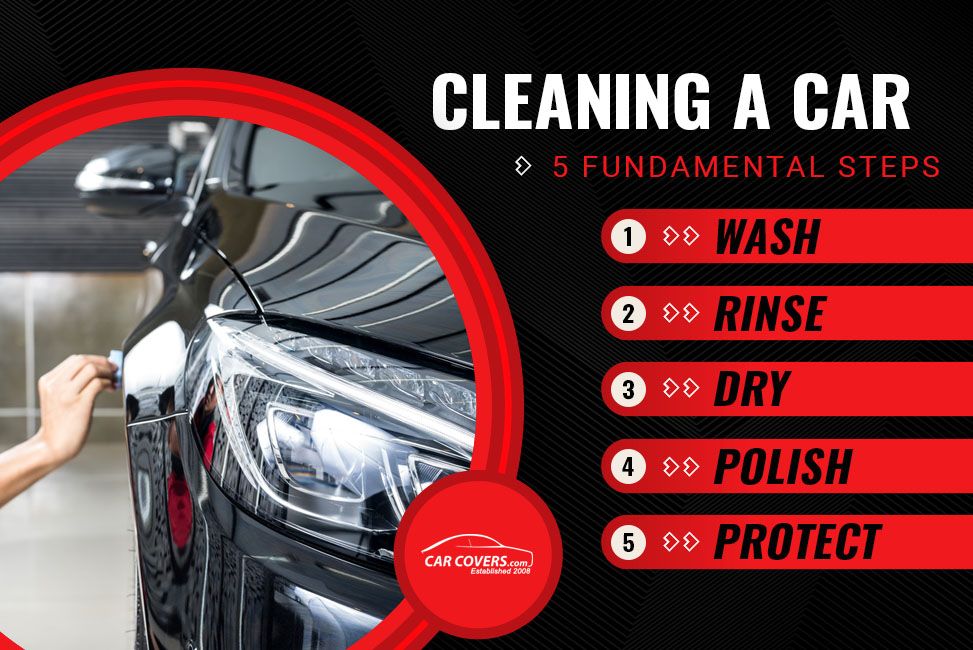
The first bucket should contain a mixture of car soap or shampoo and water. The soapy water should effectively lift dirt and other grime off the surface of your vehicle. The second bucket should contain only fresh water to rinse out your cleaning sponge or mitt before it is dunked back into the soapy bucket.
In most cases, people use the third bucket to clean the wheels. Wheels are often the dirtiest part of the vehicle and can contain potentially harmful chemicals, materials, or asphalt, which shouldn’t come in contact with your vehicle’s bodywork. Using a separate bucket and brush prevents these harsher chemicals from damaging your paint. Other uses of the third bucket include reserving it for a stronger cleaning solution to spot clean hard-to-remove stains, washing the engine bay, or rinsing a second washing mitt.
Protect Your Car with a Quality Cover
Washing and Rinsing
Before you wash the car, perform a pre-wash preparation to remove loose debris or dirt and prevent scratching your exterior when you begin using your washing mitt. Although some people use foam to complete this step, you can use a duster or cloth to remove surface dirt or debris.
Once the car has been cleared of debris, use your hose to rinse the exterior. When the car is sufficiently wet, you can begin washing. Take your microfiber cloth or washing mitt and soak it in the soapy water bucket without wringing it out. Start at the roof and work your way down in sections.
Ensure that you clean using a side-to-side motion. Avoid using a circular cleaning technique, as this is likely to create streaks. After each section, rinse your mitt in the bucket containing fresh water only. Depending on the size of the vehicle and how dirty it is, you may have to do this after every section. Make sure to wash and rinse quickly and thoroughly to prevent the water or soap from drying on the paint. To prevent premature drying and streaks, try rinsing each panel immediately after washing with soapy water. Once you’re finished cleaning the car, rinse off all excess suds and cleaning products using your hose. To effectively remove grime from the wheel wells, use a power washer.
How to Tackle the Wheels
Wheels accumulate a lot of dirt and grime from the road and engine. What’s more, if they’re not cleaned and rinsed correctly, they can spray excess cleaning product onto the paintwork, creating scratches or causing erosion. For mild to moderate grime buildup, one of the best tools for tackling the wheels is a wheel brush. Ensure you use the dedicated third bucket for the wheels only.

After a winter of salt-gritted roads, or an off-roading adventure, you may need to use a specialized wheel cleaner to get rid of tough dirt. There are several helpful cleaning products for getting your wheels sparkling clean. New generation wheel cleaners come with color-changing ingredients that switch from purple to red as the product lifts dirt and grime from the wheels. For a deep wheel clean, apply an even layer of cleaner to the wheel, and only leave it on for the amount of time as indicated by the manufacturer to prevent damage to the hubcaps and wheel bays.
Cleaning Your Windows
Car windows can be susceptible to household cleaning products so take special care when cleaning these sections. Many household glass and surface cleaners contain ammonia. These chemicals can damage the exterior finish of windows. If you’re applying a spray, use a window cleaner designed specifically for cars.
Once you’ve cleaned the window’s glass, focus on the trim around the windows. Trim not only seals the windows and keeps out moisture, but scuffed trim can also ruin the appearance of your car. Use a soft-bristled toothbrush and a paste made of baking soda and water to scrub the trim gently. Then rinse, dry, and apply a rubber trim protectant with UV filters.
Don’t Forget the Headlights
You can use Windex or soapy water to wash your headlights; however, headlights with plastic covers can turn cloudy or yellow with age. This deterioration stops them from illuminating the road effectively and can ruin the appearance of your car. You can minimize discoloration and restore foggy headlights using a paste made from baking soda and water or whitening toothpaste.
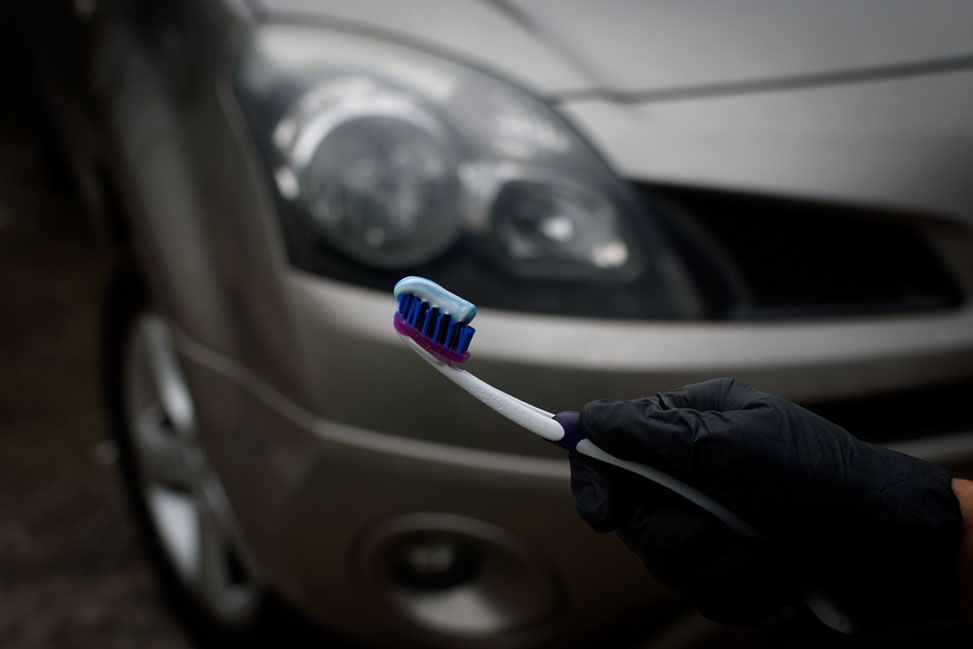
Tape off the sections around the headlights with painter’s tape. Then apply the baking soda paste to a clean, damp microfiber cloth and scrub gently. Rinse with clean water, and air dry. Apply a small amount of car wax to keep your headlights looking clearer for longer.
Drying
The drying process is crucial to avoid stains and streaking. You can use a leaf blower to remove excess water after rinsing. Alternatively, use clean microfiber towels. The towels’ fine texture and absorbent properties ensure your car dries quickly. Always check for water trapped in hidden crevices, such as the door sills, gaskets, spoilers, and the vehicle badge.
Keep Your Vehicle Protected Year Round Using a Custom Car Cover
Repair Scratches Before Polishing
When the car is washed and dried, it becomes easier to spot any minor scratches, dents, or blemishes previously obscured by dirt. Run your hand over the surface of the car to detect them. You may also find that there is excess cleaning product or oxidation after the wash. A clay bar is a valuable tool for removing any leftover oxidation marks or stubborn dirt deposits. For deeper scratches or dents, you may need an automotive professional to complete the repair.
Polish
Polishing is optional, but it gives your car a beautiful, high-gloss shine and helps restore auto paint that has lost its luster due to oxidation. Although there are polishing machines and devices, they can be tricky to operate and expensive to buy. Hand polishing is more physically demanding, but it can be just as effective.
Use a microfiber cloth or foam pad to work the polish into your vehicle’s exterior gently. Spread the polish in small circular motions until it is virtually transparent. Check the packaging on your polish to see whether it needs to be left to cure. Once the polish is cured, use a soft cloth to buff off the residue. Keep folding over the cloth to ensure you are using clean areas.
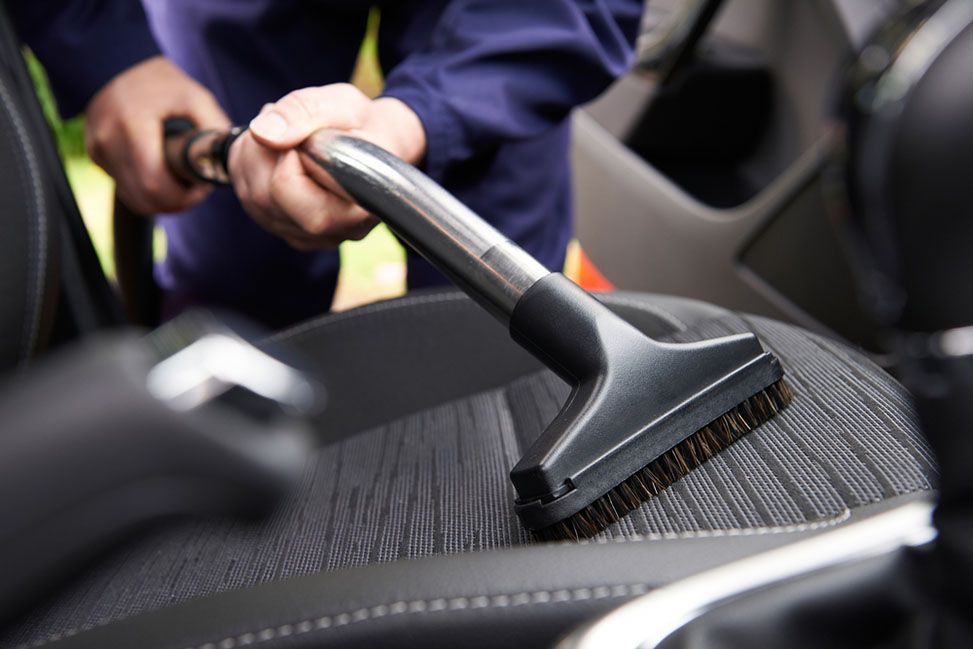
Interior Cleaning
Interior cleaning is more straightforward than exterior cleaning. Unless you have some particularly stubborn stains, a fresh valet cleaning shouldn’t take too long. Here are the most critical steps:
Take Out the Trash
Before you get down to the cleaning, you need to declutter the interior of the vehicle. Start by clearing out any lingering trash or forgotten items in your backseat.
Remove and Clean the Floor Mats
The floor mats and carpets are generally the dirtiest part of the interior, as they come in direct contact with shoes and boots. Remove the mats, shake them out, and pry out loose stones and debris. If there’s dried mud in the crevices of the mat, you may want to rinse it out with a powerful jet hose. Allow the mats to fully air-dry before placing them back into the car.
Vacuum and Clean the Carpets
Vacuum the carpets to remove any excess materials. Use the various nozzles that come with your hand or shop vacuum for hard-to-reach places. If there are any stains on the carpet, use an automotive carpet stain remover.
Clean the Seats Depending on the Material
When cleaning the seats, it’s essential to use material-specific cleaning products. While various cleaning supplies may be suitable for cloth seating, certain sprays can damage leather and vinyl materials.
Front Console, Dashboard, and Vent Cleaning Tips
For hard-to-reach places along the front console or dashboard, wrap a cloth around the head of a screwdriver and fit it through the various grooves. Cotton swabs are also helpful for getting into tight nooks.
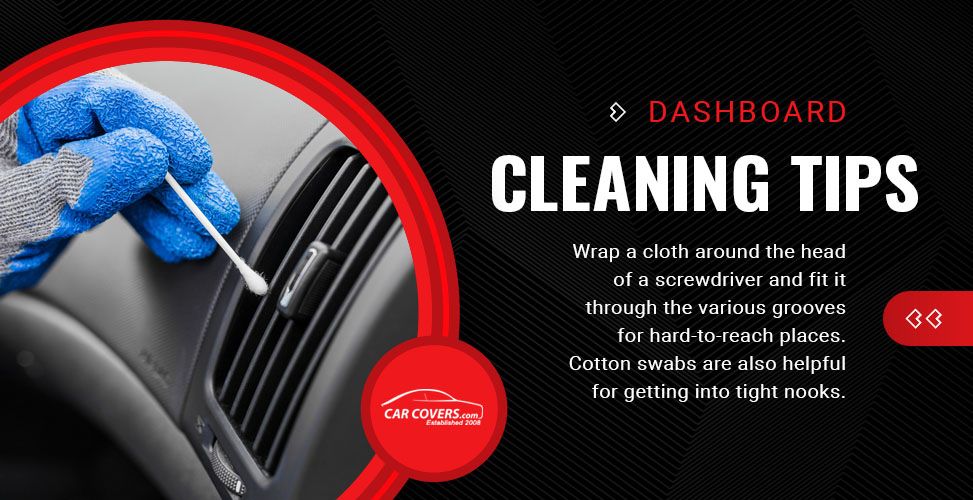
How to Maintain Your Car’s Condition
Maintaining your car’s condition goes beyond regular cleaning. Taking protective measures reduces wear and tear and ensures you don’t have to carry out thorough cleaning very regularly. One of the best ways to preserve your car after cleaning is to invest in a custom car cover. These covers are designed for your specific make and model of car, ensuring a snug fit for maximum protection.
CarCovers.com is a leading provider of these custom protective layers. Custom covers can help protect your car from unnecessary scratching or rust damage from loose debris or adverse weather. This maintains the condition of the vehicle for longer and contributes to a higher resale value. Our covers come in four main materials that vary in protection level and price. The Platinum Shield cover is one of our most popular products due to the high level of protection it provides. Besides preventing scratches and bumps, this cover protects from UV rays, acid rain, and other weather-related damage. It also comes with a lifetime warranty.
Contact CarCovers.com Today
Cleaning your car is a crucial part of your preventative maintenance routine and can prolong your car’s life and maintain its resale value. For more information on protecting your vehicle, explore our educational blog series. To protect your car, browse our full selection of custom vehicle covers online.
Updated